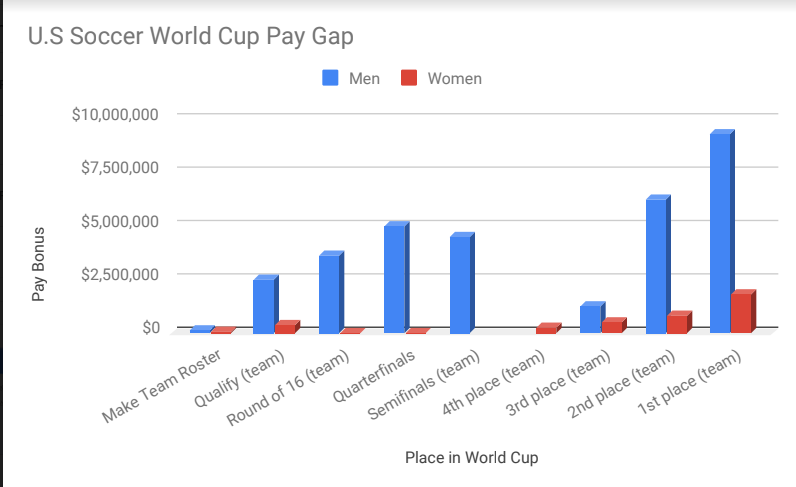Professional women athletes are an inspiration to young girls who aspire to not only play in the professional leagues but to represent their country through their sport. Sports are supposed to be an escape from the world’s problems. Unfortunately, problems such as gender inequality continue to arise through unequal pay.
The United States Women’s National Soccer Team (USWNT) has won three World Cup titles, four Olympic Gold Medals and numerous international tournaments. They have also been ranked number one in the world ten out of the past eleven years. In 2014, the men’s national team lost in the round of 16 teams of the World Cup and the program was paid $9 million by the U.S Soccer Federation (USSF), whereas the women won the international title and were paid $2 million. The women demanded equal pay to draw more public attention to the gender pay gap.
In response, a representative from the USSF stated that “market realities are such that the women do not deserve to be paid equally to the men.”
According to ESPN, the 2015 Women’s World Cup Final was the most-watched soccer game in American television history. Their 2015 World Cup victory drew tens of thousands of fans to soccer stadiums across the country. On International Women’s Day, the USWNT filed a lawsuit against the USSF for years of repeated discrimination and unequal pay.
“It’s really unfair how women don’t get as recognized as the men (do),” said senior Alfredo Gonzalez. “They made a great choice in suing the U.S Soccer Federation because they’re more talented than the guys.”
According to the lawsuit, the women’s national team earned more revenue in the 2015 Women’s World Cup than did the men in the 2015 World Cup. As a result, the USSF profited more from the women’s team in 2015 than from the men’s. Unfortunately, the USSF still paid the women less than the men.
Soccer isn’t the only sport that has a wage gap. According to witi.com, the National Basketball Association’s (NBA) first pick will earn approximately $5,091,500, whereas the Women’s National Basketball Association’s (WNBA) first pick will earn approximately $50,000. The website further states that the average starting salary of a NBA player is around $500,000. In other words, a bench warmer of the NBA will earn more than the WNBA’s best.
Although tennis has been considered the least discriminatory in major sports, when a woman does not perform in a Grand Slam tournament or “high-profile” events, she is earning 80 cents to the man’s dollar according to The New York Times. Even though it seems that tennis is the best sport for women, there is still inequality in pay.
So, why isn’t the gender wage gap a top concern in America? When looking at sports organizations and who is in charge of them, there are almost no women that hold the positions with the power to close the pay gap, such as board members of professional teams or shareholders. As the gap continues to be a consistent problem, fewer women are likely to play professional sports. Not only is the pay gap discouraging future athletes, but the lack of women in power in all professions discourages young girls from shooting for leadership roles when they grow up.
Muffet McGraw, head coach of the women’s basketball team at The University of Notre Dame, was recently asked about her commitment to never hire another male coach for her team. During a press conference after her team’s win over the University of Connecticut during the NCAA Women’s Basketball Tournament, she began to discuss how girls are trained to think that men are dominant in the world and how sports is the best place to counter that narrative.
“When you look at men’s basketball and 99 percent of the jobs go to men, why shouldn’t 100 or 99 percent of the jobs in women’s basketball go to women?” McGraw asked. “Maybe it’s because we only have 10 percent women athletic directors in Division I. People hire people who look like them. And that’s the problem.”
-By Charlie Hatch



